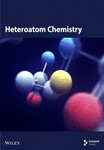X-Ray and 31P CP MAS NMR studies of bis(dialkoxythiophosphoryl) disulfides
Abstract
The crystal and molecular structures of the title compounds were determined by X-ray diffraction technique from diffractometer intensity measurements. It has been found that two homologous disulfides, bis(dimethoxythiophosphoryl) disulfide 1 and bis(dineopentoxythiophosphoryl) disulfide 2, form different molecular and crystal structures with space groups C2/c and P&1macr;, respectively. These results were confirmed by 31P CP MAS NMR studies, which showed that under favorable conditions the solid state NMR may lead to determination of the number of crystallographically unique phosphorus atoms. Moreover, the variation of the disulfide S–S bond length versus torsional P–S–S–P angles was observed.




